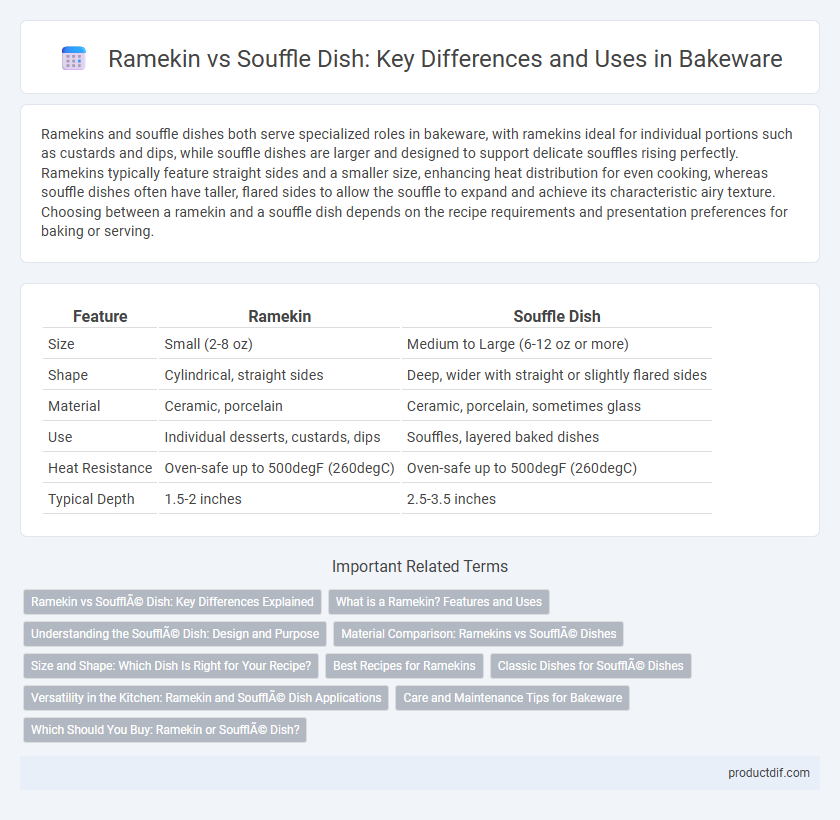Ramekins and souffle dishes both serve specialized roles in bakeware, with ramekins ideal for individual portions such as custards and dips, while souffle dishes are larger and designed to support delicate souffles rising perfectly. Ramekins typically feature straight sides and a smaller size, enhancing heat distribution for even cooking, whereas souffle dishes often have taller, flared sides to allow the souffle to expand and achieve its characteristic airy texture. Choosing between a ramekin and a souffle dish depends on the recipe requirements and presentation preferences for baking or serving.
Table of Comparison
| Feature | Ramekin | Souffle Dish |
|---|---|---|
| Size | Small (2-8 oz) | Medium to Large (6-12 oz or more) |
| Shape | Cylindrical, straight sides | Deep, wider with straight or slightly flared sides |
| Material | Ceramic, porcelain | Ceramic, porcelain, sometimes glass |
| Use | Individual desserts, custards, dips | Souffles, layered baked dishes |
| Heat Resistance | Oven-safe up to 500degF (260degC) | Oven-safe up to 500degF (260degC) |
| Typical Depth | 1.5-2 inches | 2.5-3.5 inches |
Ramekin vs Soufflé Dish: Key Differences Explained
Ramekins are small, individual-sized ceramic dishes typically used for baking custards, creme brulee, and small appetizers, featuring straight or slightly flared sides. Souffle dishes, larger and deeper with straight sides, are specifically designed to support the rising of souffles, allowing even heat distribution for a perfect puff. The primary distinction lies in size and shape, with ramekins suited for single servings and versatile baking, while souffle dishes accommodate larger, airy dishes requiring controlled expansion.
What is a Ramekin? Features and Uses
A ramekin is a small, cylindrical ceramic or glass dish typically measuring 3 to 8 ounces, designed to withstand high oven temperatures for baking and broiling. Its thick walls provide even heat distribution, making it ideal for preparing individual portions of dishes like creme brulee, custards, and souffles. Ramekins also serve versatile purposes such as holding sauces, dips, or small appetizers for serving.
Understanding the Soufflé Dish: Design and Purpose
A souffle dish is designed with taller, straight, and often fluted sides to support the rise of delicate souffles by guiding the batter upward during baking. Unlike the smaller, round ramekin, the souffle dish provides ample depth and size to accommodate the airy texture and expansion required. These dishes are typically made from heavy ceramic or porcelain to ensure even heat distribution crucial for achieving the perfect souffle structure.
Material Comparison: Ramekins vs Soufflé Dishes
Ramekins are typically made from ceramic or porcelain, providing excellent heat retention and even cooking ideal for custards and individual portions. Souffle dishes are often crafted from ceramic or glass, designed to withstand high oven temperatures and allow visual monitoring of delicate souffles during baking. Both materials offer durability and non-reactive surfaces, but ramekins excel in heat distribution while souffle dishes prioritize size and shape for optimal rise and presentation.
Size and Shape: Which Dish Is Right for Your Recipe?
Ramekins typically feature a small, cylindrical shape with a capacity of 4 to 8 ounces, ideal for individual portions or recipes requiring precise baking like custards and creme brulee. Souffle dishes are larger, often 8 to 12 ounces or more, with taller, flared sides designed to support the rise of souffles and other airy baked goods. Choosing between a ramekin and a souffle dish depends on the recipe's portion size and the importance of shape for proper cooking and presentation.
Best Recipes for Ramekins
Ramekins excel at individual servings of classic recipes like creme brulee, molten lava cake, and French onion soup, offering precise portion control and even baking. Their versatility extends to savory dishes such as mini pot pies and baked eggs, making ramekins ideal for both sweet and savory preparations. Made from ceramic or glass, ramekins retain heat efficiently, ensuring consistent texture and flavor in each dish.
Classic Dishes for Soufflé Dishes
Ramekins and souffle dishes are essential bakeware for creating classic French souffle recipes, allowing precise heat distribution and even rise. Souffle dishes typically feature higher, straight sides to support the delicate structure of both sweet and savory souffles, while ramekins are smaller and ideal for individual portions. Popular classic souffle dishes include cheese souffle, chocolate souffle, and Grand Marnier souffle, all benefiting from the specific design and material of a traditional souffle dish.
Versatility in the Kitchen: Ramekin and Soufflé Dish Applications
Ramekins offer exceptional versatility for individual portions in both sweet and savory dishes, such as creme brulee, custards, and small casseroles, making them ideal for precise serving sizes. Souffle dishes excel at accommodating larger, puffed baked recipes like souffles and baked pasta, providing ample space for rises and browning. Both bakeware types support oven-safe cooking and elegant presentation, enhancing kitchen functionality across various culinary techniques.
Care and Maintenance Tips for Bakeware
Ramekins and souffle dishes require careful handling to maintain their durability and non-stick properties, with hand washing recommended to prevent surface damage. Avoid using abrasive cleaners or metal utensils, which can cause scratches and reduce bakeware longevity. Proper storage by stacking with protective layering helps prevent chipping and cracking in ceramic and porcelain materials.
Which Should You Buy: Ramekin or Soufflé Dish?
Ramekins and souffle dishes serve distinct baking purposes, with ramekins typically measuring 4 to 8 ounces, ideal for individual portions of creme brulee or custards. Souffle dishes are larger, often 1 to 2 quarts, designed for light, airy souffles requiring taller sides for rise. Choose ramekins for personal desserts and smaller servings, while souffle dishes are better for recipes needing volume and height, like classic souffles or baked pasta.
Ramekin vs Soufflé dish Infographic

 productdif.com
productdif.com